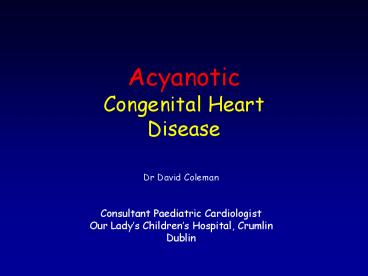Acyanotic Congenital Heart Disease - PowerPoint PPT Presentation
1 / 27
Title:
Acyanotic Congenital Heart Disease
Description:
Title: Interpretation of Paediatric Echo Reports Author: David Michael Coleman Last modified by: cardiac Created Date: 3/18/2003 10:21:19 AM Document presentation format – PowerPoint PPT presentation
Number of Views:3565
Avg rating:3.0/5.0
Title: Acyanotic Congenital Heart Disease
1
Acyanotic Congenital Heart Disease
Dr David Coleman Consultant Paediatric
Cardiologist Our Ladys Childrens Hospital,
Crumlin Dublin
2
Common Shunt Lesions
- ? Ventricular septal defect (VSD)
- ? Atrial septal defect (ASD)
- ? Patent ductus arteriosus (PDA)
All 3 lesions can lead to Eisenmengers
Syndrome if a large lesion is not detected and
treated early enough
3
Common Stenotic Lesions
- ? Pulmonary stenosis (PS)
- ? Aortic stenosis (AS)
- ? Coarctation of the aorta (CoA)
4
VSDs
- ? Commonest form of CHD
- ? Commonest types
- membranous (perimembranous) 75
- muscular
- ? Can be single or multiple
5
(No Transcript)
6
VSDs
- ? Symptoms relate to the degree of shunt (VSD
size, pulmonary vascular resistance) - if small no symptoms
- if large (high pulmonary blood flow, CHF)
- tachypnoea
- dyspnoea
- slow feeding
- failure to thrive
- sweating
7
VSDs
- ? Exam (smaller VSD)
- pink
- normal pulses
- normal S1 and S2
- systolic thrill
- harsh pansystolic murmur LLSE
- ? ECG normal (smaller VSD)
- or LVH RVH (larger VSD)
8
VSDs
- ? Larger defect
- MDM _at_ apex (mitral flow murmur)
- narrowly split S2 and loud P2
- S3
- CXR cardiomegaly
- increased pulmonary vascularity
9
VSDs
- ? Treatment options
- Nil (spontaneous closure)
- Surgical closure
- Device closure
10
ASDs
- ? Three types secundum
- primum
- sinus venosus
- ? Commonest secundum
- ? Primum a form of atrioventricular septal
(canal) defect
11
(No Transcript)
12
(No Transcript)
13
Secundum ASD
- ? Usually no symptoms in childhood
- ? Exam pink
- normal pulses
- wide fixed split S2
- soft ESM _at_ ULSE
- ? ECG incomplete RBBB (95)
- ? CXR often normal
- sometimes pulmonary plethora
14
Secundum ASD
- ? Haemodynamic significance of ASD is assessed
to decide if closure appropriate - ? Usually closed age 3-5 years (earlier if
symptomatic) or when diagnosed if later - ? Two options for closure
- surgery - suture or patch
- interventional catheter - device
15
Amplatzer ASD Occluder
16
PDA
- ? CHF symptoms if large ductus in very young
infant, otherwise often asymptomatic - ? Exam pink
- full volume pulses
- harsh systolic (1st few weeks) or
continuous machinery murmur loudest under
left clavicle - ? ECG normal (small PDA)
- LVH RVH (large PDA)
17
(No Transcript)
18
PDA
- ? CXR cardiomegaly, pulm plethora
- ? Options for closure
- surgery - ligation
- interventional catheter - coil(s) or device
19
Pulmonary Stenosis
- ? Usually asymptomatic
- ? Exam pink
- normal pulses
- systolic ejection click
- ESM loudest _at_ ULSE if severe, S2 widely
split (not fixed)
20
(No Transcript)
21
Pulmonary Stenosis
- ? ECG RAD, RVH
- ? CXR normal
- prominent MPA (post-stenotic dilatation)
- ? Treatment of valvar PS (moderate/severe)
- balloon valvuloplasty preferred
- uncommonly surgical valvotomy
22
Aortic Stenosis
- ? Often asymptomatic
- otherwise SOB, syncope or chest pain on exertion
- ? Exam pink
- small volume pulse, small pulse pressure
- LV lift
- systolic thrill (suprasternal, URSE)
- systolic ejection click
- harsh ESM loudest _at_ URSE radiating to
carotids - if severe, narrow split S2 (even reversed)
23
(No Transcript)
24
Aortic Stenosis
- ? ECG normal (mild AS)
- LVH strain (more severe AS)
- ? CXR often normal
- dilated ascending aorta
- ? Treatment of valvar AS (moderate/severe)
- balloon valvuloplasty
- surgical valvotomy
25
Coarctation of the Aorta
- ? CHF in neonate if severe CoA
- often asymptomatic in older child
- ? Exam pink
- reduced or absent femoral pulses
- soft systolic murmur mid LSE
- and/or mid left back
- ? ECG RVH in 1st few months of life,
- LVH if older
26
(No Transcript)
27
Coarctation of the Aorta
- ? CXR cardiomegaly
- evidence of CHF
- rib notching (older child)
- ? Treatment
- surgery for native CoA
- balloon angioplasty for re-CoA































